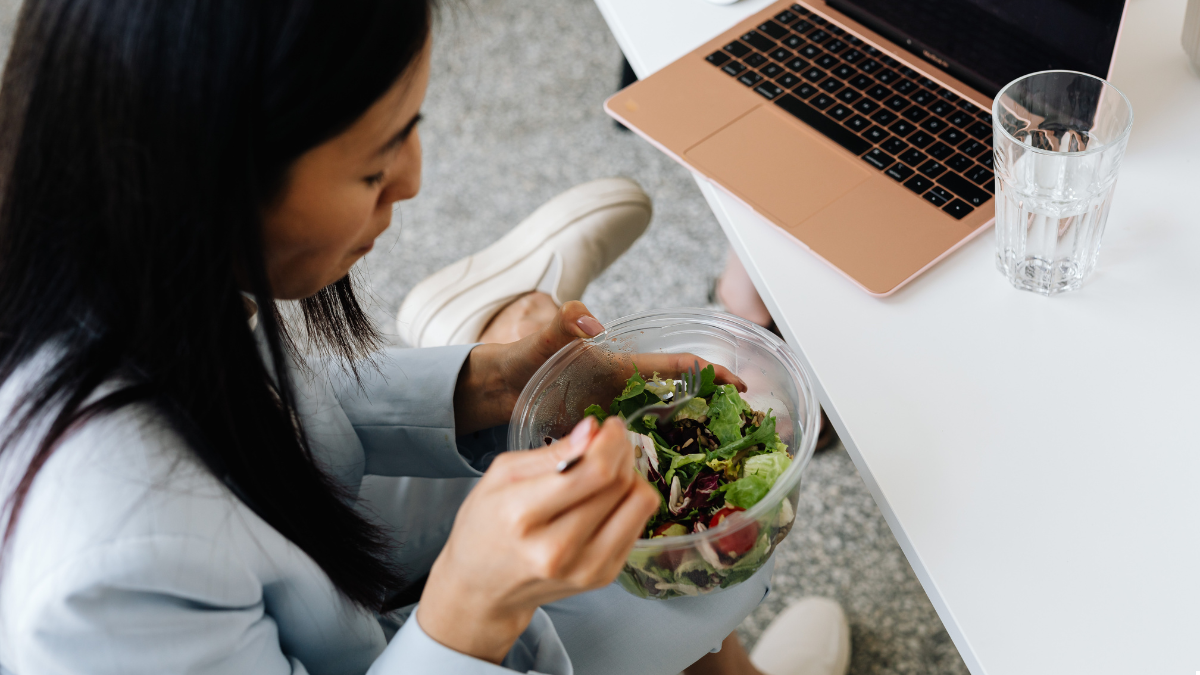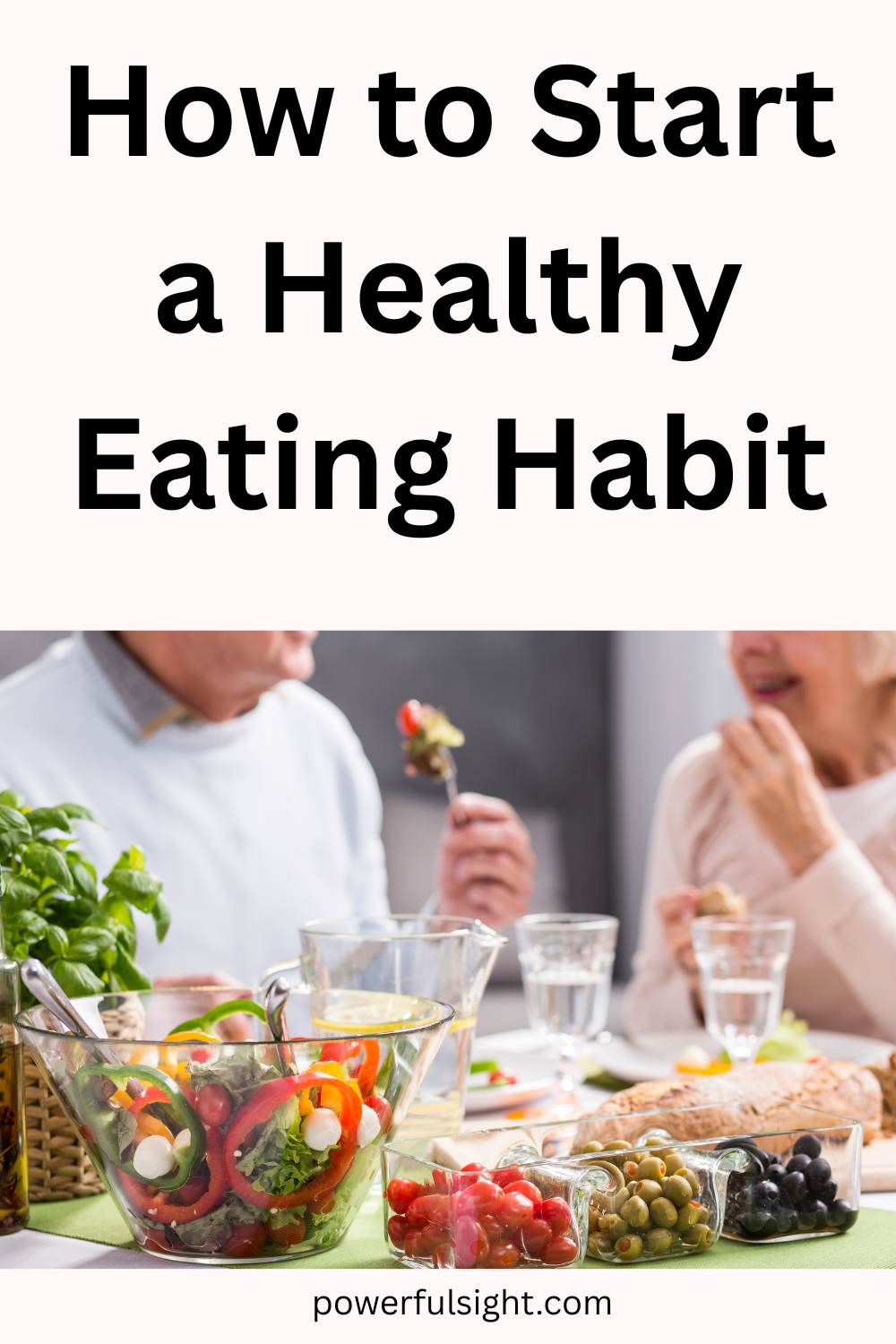You know you should be eating healthier — more fruits and veggies, less fast food and sugary drinks. More water. Fewer chips.
You know what to do. The problem is actually doing it, day in and day out — that’s another story.
The good news? You don’t have to punish yourself with a restrictive diet to build healthy eating habits. You don’t have to give up all your favorite foods, either. (Long live bread and cheese, you guys.)
Healthy eating is simple — well, sort of. It’s about mindfulness, balance, and consistency. In this post, we’ll break down exactly how to build healthy eating habits — and how to make them stick.

How to Start a Healthy Eating Habit
1. Know What “Healthy Eating” Is (and Isn’t)
It’s important to know what we’re even trying to do before we start. There’s a lot of conflicting information out there about what “healthy eating” really means.
Healthy eating is not calorie counting or surviving on plain chicken and broccoli.
Healthy eating is not deprivation or restriction.
Healthy eating is not a diet — it’s a lifestyle.
Healthy eating is about nourishing your body with nutrients — lots of fruits, vegetables, whole grains, lean proteins, and healthy fats — while still enjoying food and eating what you love.
Here’s a simple formula to keep in mind:
Eat more of:
-
Colorful fruits and vegetables
-
Whole grains
-
Nuts, seeds, and legumes
-
Lean protein (chicken, fish, beans, tofu, eggs)
-
Healthy fats (olive oil, avocado, nuts)
Eat less of:
-
Highly processed snacks and foods
-
Sugary drinks
-
Fried foods
-
Refined carbohydrates (white bread, pastries)
Pay attention to hunger and fullness cues. Eat when you’re hungry and stop when you’re satisfied.
Healthy eating can look different for everyone — it depends on culture, preferences, budget, and more. It’s not about being perfect. It’s about making progress.
Related: 20 Good Habits To Start In Your 20s
2. Take It One Baby Step at a Time
Here’s a major rookie mistake people make when trying to eat healthier: they overhaul their pantry, wipe it clean, and restock with quinoa and chia seeds.
They vow to never eat chocolate again.
Uh, no. Drastic change rarely works because it’s hard to sustain. If eating healthy feels like a chore, you’re more likely to give up.
The key is to take small, manageable steps that add up to a big impact.
Here are some examples:
-
Add one serving of vegetables to lunch or dinner.
-
Swap soda for sparkling water once per day.
-
Eat fruit for dessert instead of ice cream a few nights a week.
-
Cook one homemade meal per week instead of ordering takeout.
Don’t focus on eliminating foods or “eating perfectly.” Instead, add healthy habits — one small step at a time. Then build on them. Think of it as stacking building blocks, little by little, until you have something solid.
Related: 42 Healthy Habits To Track Daily To Improve Your life
3. Fill Up on Balanced Meals
A balanced meal keeps you full, energized, and satisfied. That means getting a good mix of macronutrients (carbs, protein, and fat) and fiber.
Don’t stress about weighing or measuring food. Instead, use this simple visual guide:
The Healthy Plate Method:
-
½ plate: fruits or vegetables
-
¼ plate: whole grains (brown rice, quinoa, whole wheat pasta)
-
¼ plate: lean protein (chicken, fish, beans, tofu, eggs)
Add a small portion of healthy fat like olive oil, avocado, or nuts.
The Healthy Plate Method gives you a balance of fiber, protein, and healthy fats that help keep you full, support digestion, and regulate your energy levels throughout the day.
Related: Feeling Burned Out At Work? 7 Ways To Maintain A Healthy Work-Life Balance
4. Plan Ahead (But Keep It Flexible)
Meal planning and preparation are game-changers when it comes to eating healthy. It’s so much easier to make good choices when you have a plan — especially when you’re hungry or tired.
Try these meal prep and planning tips:
-
Prep in batches on weekends. Grilled chicken, roasted veggies, and cooked grains can be mixed and matched throughout the week.
-
Make a grocery list before you shop so you don’t get sidetracked by temptations in the store.
-
Keep healthy snacks on hand so you have quick, easy options when hunger strikes between meals.
Life happens. You don’t have to be perfect with your plan. If you grab takeout or eat out with friends, it’s fine. Just get back on track at your next meal.
Related: 18 Ways To Be Healthy and Happy
5. Eat Whole Foods, Not Packaged Ones
One of the easiest ways to eat healthier is to choose whole foods over processed ones.
Whole foods include fruits, vegetables, whole grains, nuts, seeds, legumes, eggs, and fresh meat or fish.
Processed foods include chips, cookies, soda, fast food, packaged meals — basically, anything that comes in a box, bag, or wrapper.
Processed foods often contain added sugars, salt, and unhealthy fats, which can impact your energy levels and overall health.
You don’t have to avoid all processed foods, but try to make whole foods the foundation of your diet. When you do buy packaged foods, check the ingredients list — the fewer, the better.
Related: These 8 Eating Habits Reveal Your Partner Is a Narcissist
6. Drink More Water
This one sounds so simple, it’s easy to forget how important water is — not only for your health but also for managing hunger and energy.
Sometimes we get thirsty and think we’re hungry. (Truth.)
Thirsty? Drink water.
Hungry? Eat food.
Aim for about 6–8 cups of water per day, but listen to your body and adjust as needed. If you’re active or live in a hot climate, you may need more.
If plain water bores you, try adding lemon, cucumber, or berries for flavor — or sip on herbal tea.
Cutting back on sugary drinks like soda or sweetened coffee and tea can also make a big difference in your overall health and energy levels.
7. Practice Mindful Eating
Mindful eating is the art of paying attention to your food — not just what you eat, but how you eat it.
Instead of munching on lunch while scrolling through your phone or watching TV, sit down and savor your food. Take the time to chew and enjoy the flavors.
Tips for mindful eating:
-
Put down your fork between bites.
-
Eat without distractions.
-
Tune in to your body’s hunger and fullness signals.
-
Don’t rush — meals are meant to be enjoyed!
When we eat mindfully, we’re more likely to enjoy our food — and less likely to overeat.
8. Allow Yourself to Treat Yourself
Healthy eating is not about deprivation. It’s not all carrots and quinoa every day (sorry, not sorry).
A healthy diet allows room for treats and indulgences — in moderation.
You can still have pizza, ice cream, chocolate, and your other favorite foods.
Enjoy them! Savor them. Just eat them mindfully and in moderation.
One helpful strategy is the 80/20 rule: try to eat nutritious, whole foods 80–90% of the time and allow flexibility the rest of the time.
Balance is key. Enjoy your favorite treats — just don’t let them take over your plate (or your kitchen).
9. Learn to Listen to Your Body
Your body speaks to you in subtle ways about what it needs. Hunger and fullness cues, energy levels, fatigue, and even mood changes can all be related to what you eat.
Tips for tuning in:
-
Do certain foods leave you feeling sluggish or bloated?
-
Do other foods energize and satisfy you?
-
Are you eating because you’re truly hungry, or because you’re stressed, bored, or out of habit?
As you get better at listening to your body’s cues, you can build a more intuitive and sustainable relationship with food.
10. Be Patient and Kind to Yourself
Remember, building a healthy eating habit is a marathon, not a sprint. You can’t change your habits overnight.
It will take time. Some days, you’ll eat too much. Some days, you’ll skip meals. Some days, you’ll reach for a chocolate bar instead of an apple. That’s okay.
One meal or one day doesn’t make or break your habit. Focus on the big picture — consistent progress over time.
Don’t aim for perfection. No one eats perfectly 100% of the time (and that’s okay).
Celebrate small victories:
-
You drank more water today? Awesome.
-
You added vegetables to your breakfast? Score.
-
You cooked at home instead of ordering in? High five.
Every healthy choice you make counts — even the small ones.
11. Make It Fun
If eating healthy feels like a chore, it won’t stick.
Healthy eating should be enjoyable! Here are some ways to make it fun:
-
Experiment with new recipes and cuisines. Don’t just eat the same things over and over — have fun in the kitchen.
-
Cook with friends or family. Meal prep can be more enjoyable (and a great way to connect) when you do it together.
-
Shop at a local farmer’s market. It’s a great way to support local growers and get fresh, seasonal produce.
-
Listen to music or a podcast while you cook. Make the process enjoyable with some background entertainment.
If you enjoy cooking and eating healthy food, you’re far more likely to stick with it.
12. Don’t Be Afraid to Ask for Help
If you need a little help or support, don’t be afraid to reach out.
You can:
-
Follow nutritionists, dietitians, and health coaches on social media for inspiration and realistic advice.
-
Take a healthy cooking class to learn new skills and recipes.
-
Get your friends or family involved in your healthy eating journey — having accountability makes it easier to stay consistent.
If you have specific health conditions, allergies, or dietary needs, consider seeing a registered dietitian. They can help you create a personalized plan based on your needs, preferences, and goals.
Final Thoughts
Building a healthy eating habit isn’t about depriving yourself or following a strict, hard-to-sustain diet plan. It’s about making small, consistent changes that nourish your body and help you enjoy food.
Healthy eating is a lifelong relationship with food built on self-care, balance, and enjoyment. It’s about progress, not perfection.
Start small, stay consistent, and be kind to yourself.
You’ve got this.
Save pin for later.

- How to Find Out Your Aura - 20/11/2025
- If The Guy You’re Dating Doesn’t Sleep With You, 10 Things It Means - 20/11/2025
- How to Start a Healthy Eating Habit - 20/11/2025